Division of Bacterial Diseases (DBD) News Bulletin
Summer 2015
In This Issue
- Exploring Meningococcal Outbreaks & Carriage
- White House Forum on Antibiotic Stewardship
- New EIS Officers & LLS Fellow
- DBD Supports the Ebola Response
- MenAfriNet Partners Respond to Niger Outbreak
- Laboratory & Communications
- Vaccine News & Meetings
- Awards
- Epi-Aids & Outbreak Investigations
- Publication Highlights
DBD: All Hands on Deck to Support the Ebola Response
At CDC, it is our mission to respond to new and emerging health threats, both foreign and domestic. In March 2014, a single case of Ebola in a child in Guinea led to the largest epidemic of Ebola ever recorded. CDC, along with other U.S. government agencies, the World Health Organization (WHO), and international partners, became actively involved in responding to the outbreak in March 2014 and deployed the first five person team to Guinea by the end of the month.
It would have been impossible to predict that by June the following year (2015), Guinea, Sierra Leone, and Liberia would have more than 27,500 suspected, probable, and confirmed cases of Ebola and 11,220 fatalities. July 9, 2015 marked the one-year anniversary of the activation of CDC’s Emergency Operations Center (EOC) to respond to this epidemic.
The Division of Bacterial Diseases (DBD) is providing substantial support in the fight against Ebola. As of July 2, 2015, DBD staff members worked more than 2,300 person days with 44 individuals assigned to tasks domestically and in countries with outbreaks. Domestically, DBD staff members worked in the EOC on many different teams and task forces, including the infection control team, rapid response team, vaccine task force (STRIVE), and the domestic task force. DBD staff members were also deployed to Guinea, Liberia, and Sierra Leone as well as countries with smaller outbreaks, like Nigeria and Mali. DBD continues to provide both in-country and domestic support with many staff members still on detail or with future details scheduled.
Out of the many DBD staff who supported the response, here are just a few examples reflecting the division’s work―told in their own words.
Rana Hajjeh, Division Director, Division of Bacterial Diseases
Response Lead, Guinea, 3/23/2015–4/26/2015
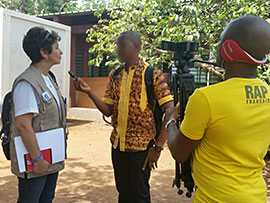
Photo: Rana Hajjeh being interviewd by the local radio station in Forecariah, Guinea where her team launched the first public awareness campaign in collaboration with the MOH in April 2015.
I was in Guinea for 5 weeks (March–April 2015) as the lead of the CDC response team. We were doing everything: providing support for the national Emergency Operations Center, surveillance, contact tracing and other epidemiologic activities, laboratory capacity, multiple rapid diagnostics building and evaluation, quarantine and border efforts, strengthening infection control capacity, communications, coordinating with multiple partners and closely working with the Ministry of Health (MOH), and a lot more. It was extremely busy and we often worked 18 to 20 hour days, but we had a great team that kept going and understood the importance of its mission.
I was based in Conakry, but I often went to the field, as it was important to check the epidemiologic situation firsthand and follow up with many of our staff in the provinces. Together with the MOH, CDC helped plan the first door-to-door awareness campaigns that were critical to improving case finding and contact tracing.
My best memories are from these field visits, whether by car (long rides due to terrible traffic and bad road conditions) or preferably by helicopter (with the United Nations). I remember one day meeting an Ebola survivor while visiting one of the rural health departments. She had come back with a huge container of cooked rice that she presented as a gift to the staff who took her to the Ebola treatment center when she became sick. I was very touched by this woman, who lost her husband, mother-in-law, and son, but was back to thank the healthcare workers!
Another great field visit was to the Ebola treatment unit that was set up by the French military to treat all Guinean and other healthcare workers who develop Ebola. It was a state of the art unit (the best I have seen in the region) that provided great care (survival rate of about 70%!) and it was very heartwarming to see such care provided to these workers who were putting their lives on the line each day.
Another lasting memory from all my Ebola assignments is that I got to work and meet many wonderful colleagues from all over CDC that I would not have worked with otherwise. We truly have a great workplace!
Jennifer Loo Farrar, Epidemiologist, Respiratory Diseases Branch
Active Monitoring Team, Atlanta, GA, 12/1/2014–1/8/2015
I served on the Employee Active Monitoring Team as a team member (under Lauri Hicks) and then as Team Lead. Our team monitored the overall health of CDC employees returning from countries with Ebola outbreaks, including those assigned to and returning to international offices. We were often one of the first points of contact for returning deployers and we conducted 21-day active monitoring for signs and symptoms related to Ebola. We worked a lot with other teams in the CDC Emergency Operations Center, state health departments, and other federal agencies to coordinate efforts.
During my detail, we were able to move from Georgia-based employees having to report to both CDC and the Georgia Department of Public Health to one integrated system for reporting.
I really enjoyed working with people from all over CDC who I may never have interacted with otherwise in my regular job. I also enjoyed being able to welcome fellow colleagues home after their field deployments and be a listening ear or voice of encouragement during their transition back to life in the United States. Working on the Ebola response reminded me why I love public health and CDC―I got to work with so many incredible people from all over the agency literally doing life-saving work.
Heidi Soeters, EIS Officer, Meningitis and Vaccine Preventable Diseases Branch
Healthcare Infection Prevention Team, Guinea, 11/7/2014–12/10/2014
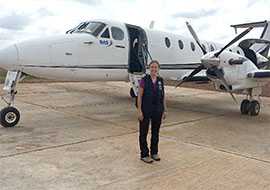
Photo: Heidi Soeters arriving in N’Zérékoré, Guinea, in November 2014 to begin four weeks of field work.
As a member of the Healthcare Infection Prevention Team, I had two main roles: 1) to help develop a curriculum and conduct infection control trainings for healthcare workers, and 2) to conduct infection control assessments at health facilities. I spent the majority of my deployment in southeastern Guinea in the prefectures of N’Zérékoré and Macenta, where we trained more than 700 frontline healthcare workers, including everyone from doctors and nurses to janitors and ambulance drivers. The training included classroom sessions and hands-on exercises in handwashing, triaging patients, putting on and taking off personal protective equipment, and cleaning up contaminated fluids.
I will never forget how eager the healthcare workers were for training, support, and basic infection control supplies. Two particular moments stick out in my mind. One was on our first day of training in N’Zérékoré, were we had 80 students enrolled and were astonished to find that more than 200 had shown up, pleading to have a spot in the course. The second moment was when a training day ran late and the classrooms without electricity grew dark. I expected people to be tired and want to go home, but they pulled out flashlights and refused to leave until all of the material was covered. The first time this happened, it was a big surprise, but these late sessions became a daily occurrence.
As this was my first international emergency response, I learned a lot from watching how everyone came together as one big team. On a daily basis, we were working side-by-side with local healthcare staff, the Ministry of Health, CDC, the World Health Organization (WHO), the United States Agency for International Development (USAID), the United Nations Children’s Fund (UNICEF), Catholic Relief Services, the United Nations Mission for Ebola Emergency Response (UNMEER), Médecins Sans Frontières (MSF, or Doctors Without Borders), World Food Program, and many others. The collaboration and mutual support was incredible, and I left the experience with many lasting friendships.
Brian Harcourt, Microbiologist, Meningitis and Vaccine Preventable Diseases Branch
Lab Team, Liberia, 1/11/2015–2/24/2015
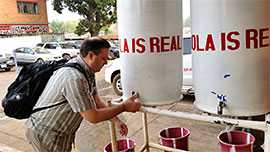
Photo: Brian Harcourt washing his hands during January 2015 in chlorinated water outside in Liberia―where the water tanks remind you that "EBOLA IS REAL."
I was sent to Liberia in January 2015 to be the CDC Lead Laboratory Coordinator. I also went under the WHO’s Global Outbreak Alert & Response Network as a consultant and ended being the CDC liaison to the U.S. military. The roles were so dynamic that it is difficult to describe the job. At one point I made a list of projects/responsibilities to share with my incoming deputy but had to stop at 23 because some other fire had to be put out. There was never a dull moment, to be sure.
Most days were a mix of day-to-day laboratory needs to meet, including fuel supply, distilled water for battery powered cold storage units in the field, obtaining results in a rush, results reporting questions, lab security); short-term laboratory planning such as the transition plan for ensuring the closure of the 41st Army Medical Laboratories (1st AML) did not impact laboratory coverage and how to reorganize and coordinate specimen transport to the enduring labs to minimize disruption and to give the best opportunity to maintain a 24-hour turnaround time from specimen draw to result throughout the country; and long-term strategic planning for health restoration and development of laboratory and surveillance systems.
The long-term planning pertained not only to Ebola, but also to other infectious diseases such as measles, malaria, yellow fever, and Lassa fever. This planning was done with other members of the CDC Liberia Team, partners from the Ministry of Health, USAID’s Disaster Assistance Response Team, Department of Defense (DoD), Defense Threat Reduction Agency, WHO, World Bank, and several non-governmental organizations (NGOs), including our close partners: Academic Consortium Combating Ebola in Liberia, Riders for Health, MSF, Global Communities, and more.
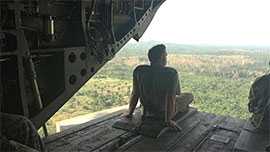
Photo: Brian Harcourt taking a breather on the edge (tethered) of a Chinook helicopter traveling from Tappita to Monrovia while in Liberia working on the Ebola response in January 2015.
In my role as liaison to the U.S. military (Operation United Assistance), I attended the Commanding General’s Update Briefing several times a week; briefed Major General Volesky (the commanding general of Operation United Assistance Joint Forces Command―and commanding general of the 101st Airborne Division) as necessary; worked closely with the 1st AML commander, COL Patrick Garman, to synchronize the transition plan with CDC’s plan and the needs of the country after their departure; andflew to each of the four lab sites with DoD and MOH representatives to inform local health officials and leaders of the closure of 1st AML lab in that area (Sanniquellie, Tappita, Zwedru, and Greenville) of the timeline for the lab closures, the plan on where their specimens were to be tested, and the mechanism to use to transport the specimens to the proper enduring lab, and to listen to their concerns.
As you can imagine, I can’t even come close to writing about everything that my lab team, with our CDC Liberia Team colleagues and partners, were involved in, but those are some highlights. I have stories galore!
Choosing one experience out of 1,000 memorable experiences is tough. This deployment certainly was the most powerful experience of my professional life and ranks pretty high on my life’s experience list, too. The overall experience of being part of a response this enormous, working in unison with so many partners towards a common humanitarian goal vital not only to that region, but globally, is singular and indescribable. I’m thankful to have had the opportunity to serve and am honored and humbled to have worked with so many incredibly talented and dedicated people from Liberia, the United States, and around the world.
One specific memorable experience was meeting and talking with an Ebola survivor working as a nurse in the Sinje Ebola treatment unit (Grand Cape Mount county). She was infected early in the outbreak in Lofa county where she was working as a nurse. She ended up working with sick kids at the Sinje Ebola treatment unit because they weren’t afraid of her. She is an inspiration!
I really had no idea that my boundaries could be pushed so far outside of my comfort zone and that I would, in turn, love that. It was nerve-wracking at times, but I wouldn’t trade the experience for anything.
Stephanie Schrag, Epi Team Lead, Respiratory Diseases Branch
STRIVE Team Lead, Atlanta, GA, 12/8/2014–ongoing
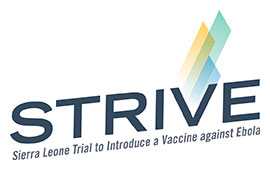 On the Ebola Vaccine Task Force, I served as the U.S. co-principal investigator (PI) for STRIVE, which is the Sierra Leone Trial to Introduce a Vaccine against Ebola. There was another CDC co-PI (Marc-Alain Widdowson from the Influenza Division) and a PI in Sierra Leone (Mohamed Samai from the College of Medicine and Allied Health Sciences, University of Sierra Leone), plus a team of people from across CDC working in Atlanta and Sierra Leone. As co-PI, one of my main responsibilities was writing the study protocol, including developing and implementing a vaccine safety monitoring plan.
On the Ebola Vaccine Task Force, I served as the U.S. co-principal investigator (PI) for STRIVE, which is the Sierra Leone Trial to Introduce a Vaccine against Ebola. There was another CDC co-PI (Marc-Alain Widdowson from the Influenza Division) and a PI in Sierra Leone (Mohamed Samai from the College of Medicine and Allied Health Sciences, University of Sierra Leone), plus a team of people from across CDC working in Atlanta and Sierra Leone. As co-PI, one of my main responsibilities was writing the study protocol, including developing and implementing a vaccine safety monitoring plan.
My most memorable experience was probably coming in and changing the study design as the epidemic evolved and making sure all the study partners were on board to make that change. When I came onto the trial, the decision was to do a design called a stepped wedge and everybody was referring to the trial as "the stepped wedge trial." But that’s not a very common design and as I learned more about it, it became apparent that it wasn't going to be a good fit for what we needed to do in the field―both for the scientific objectives but also for the field realities. So we had to come up with a way to shift the design that the leadership would feel comfortable with and all the communication messages to Sierra Leone would remain relatively consistent despite the fact that we needed to change how we were approaching the trial. So we changed it to an individually randomized design, which still did not use a placebo. You can learn more about the trial and its design.
I’ve learned so many things. Overall, I learned how to work on something when the landscape keeps changing and nobody in the agency has done something quite like this before in a setting that has no experience ever doing this kind of study. The fact that we have launched a trial and enrolled around 8,500 people and vaccinated about half of them as of mid-August is a real testament to the dedication of Sierra Leone to rise to this very unusual occasion and to the dedication to all of the partners to help support them and make it happen. This has been a once in a lifetime opportunity.
- Page last reviewed: September 28, 2015
- Page last updated: September 28, 2015
- Content source:


 ShareCompartir
ShareCompartir